A 3D Printing Method of Cement-Based FGM Composites Containing Granulated Cork, Polypropylene Fibres, and a Polyethylene Net Interlayer
Abstract
1. Introduction
2. Materials
3. Methods
3.1. Specimen Preparation
3.1.1. Forming
3.1.2. Curing
3.1.3. Machining
3.1.4. Measurements
3.1.5. Freeze–Thaw Resistance
3.1.6. Mechanical Tests
Three-Point Bending (3PB) Test
Uniaxial Compression Test
4. Results and Discussion
4.1. Measurements, Observations, and Calculations
4.2. Freeze–Thaw Test
4.3. Three-Point Bending (3PB) Test
4.4. Uniaxial Compression Test
5. Conclusions
- The material’s water absorption by weight was 14%.
- The analysed composite showed adequate frost resistance. The specimens did not show any changes after freeze–thaw treatment.
- After 25 freeze–thaw cycles, the material showed 11.2% higher compressive toughness in the direction of the height axis and 11.8% higher values in the direction of the length axis but also showed 1.0% lower flexural strength.
- The use of net-type continuous reinforcement allowed for better buildability and additionally lowered slumping and elephant’s foot effects.
- The use of a polymer net as continuous reinforcement led to a decrease in compressive toughness, lowering it on average by 38.5% for the stacking direction and 23.8% perpendicular to the stacking direction. The net was not stiff enough, and thus it did not work as proper reinforcement. Nevertheless, it allowed for the composite to partially work after the first signs of failure because of its residual strength.
- The composite showed orthotropic properties. The uniaxial compressive strength in the direction of layer stacking was lower than that of the direction perpendicular to it, by 42.6% in the case of net reinforcement without heat treatment, 42.9% in the case of net reinforcement followed by the freeze–thaw test, and 29.8% without net reinforcement and heat treatment [15,41,46].
Author Contributions
Funding
Institutional Review Board Statement
Informed Consent Statement
Data Availability Statement
Conflicts of Interest
References
- Kim, S.H.; Yeon, S.-M.; Lee, J.H.; Kim, Y.W.; Lee, H.; Park, J.; Lee, N.-K.; Choi, J.P.; Aranas, C., Jr.; Lee, Y.J.; et al. Additive manufacturing of a shift block via laser powder bed fusion: The simultaneous utilisation of optimised topology and a lattice structure. Virtual Phys. Prototyp. 2020, 15, 460–480. [Google Scholar] [CrossRef]
- Zhang, J.; Wang, J.; Dong, S.; Yu, X.; Han, B. A review of the current progress and application of 3D printed concrete. Compos. Part A Appl. Sci. Manuf. 2019, 125, 105533. [Google Scholar] [CrossRef]
- Inozemtcev, A.; Duong, T.Q. Technical and economic efficiency of materials using 3D-printing in construction on the example of high-strength lightweight fiber-reinforced concrete. E3S Web Conf. 2019, 97, 02010. [Google Scholar] [CrossRef]
- Bos, F.; Wolfs, R.; Ahmed, Z.; Salet, T. Additive manufacturing of concrete in construction: Potentials and challenges of 3D concrete printing. Virtual Phys. Prototyp. 2016, 11, 209–225. [Google Scholar] [CrossRef]
- Tosun, Y.; Sahin, R. Developments of 3D Concrete Printing Process. In Proceedings of the International Civil Engineering and Architecture Conference, Trabzon, Turkey, 17–20 April 2019; pp. 2394–2404. [Google Scholar]
- Duballet, R.; Baverel, O.; Dirrenberger, J. Classification of building systems for concrete 3D printing. Autom. Constr. 2017, 83, 247–258. [Google Scholar] [CrossRef]
- Paul, S.C.; Van Zijl, G.P.; Tan, M.J.; Gibson, I. A review of 3D concrete printing systems and materials properties: Current status and future research prospects. Rapid Prototyp. J. 2018, 24, 784–798. [Google Scholar] [CrossRef]
- Buswell, R.; da Silva, W.L.; Bos, F.; Schipper, H.; Lowke, D.; Hack, N.; Kloft, H.; Mechtcherine, V.; Wangler, T.; Roussel, N. A process classification framework for defining and describing Digital Fabrication with Concrete. Cem. Concr. Res. 2020, 134, 106068. [Google Scholar] [CrossRef]
- Buchanan, C.; Gardner, L. Metal 3D printing in construction: A review of methods, research, applications, opportunities and challenges. Eng. Struct. 2019, 180, 332–348. [Google Scholar] [CrossRef]
- Nerella, V.N.; Hempel, S.; Mechtcherine, V. Micro-and Macroscopic Investigations on the Interface Between Layers of 3D-Printed Cementitious Elements. Int. Conf. Adv. Constr. Mater. Syst. 2017, 9, 3–8. [Google Scholar]
- Jakupovic, A. D-Shape—Report. no. 3D Printhuset A/S. 2016. Available online: http://3dprintetbyggeri.dk/pdf/besøgsrapporter/XtreeE.pdf (accessed on 21 April 2023).
- Bester, F.; van den Heever, M. 3D Printing of Concrete within the South African Building and Construction Industry. Greenovate Award. 2018. Available online: https://www.researchgate.net/publication/329365708 (accessed on 21 April 2023).
- Puzatova, A.; Shakor, P.; Laghi, V.; Dmitrieva, M. Large-Scale 3D Printing for Construction Application by Means of Robotic Arm and Gantry 3D Printer: A Review. Buildings 2022, 12, 2023. [Google Scholar] [CrossRef]
- Bos, F.P.; Ahmed, Z.Y.; Jutinov, E.R.; Salet, T.A.M. Experimental Exploration of Metal Cable as Reinforcement in 3D Printed Concrete. Materials 2017, 10, 1314. [Google Scholar] [CrossRef] [PubMed]
- Valente, M.; Sibai, A.; Sambucci, M. Extrusion-Based Additive Manufacturing of Concrete Products: Revolutionizing and Remodeling the Construction Industry. J. Compos. Sci. 2019, 3, 88. [Google Scholar] [CrossRef]
- Panda, B.; Paul, S.C.; Hui, L.J.; Tay, Y.W.D.; Tan, M.J. Additive manufacturing of geopolymer for sustainable built environment. J. Clean. Prod. 2017, 167, 281–288. [Google Scholar] [CrossRef]
- Zindroski, J.; Razzhivina, M.; Shayani, H. ReCrete Fabrication Strategies for Precise Application of Reinforcement in 3D-Printed Concrete; University Stuttgart: Stuttgart, Germany, 2018; pp. 1–124. Available online: https://www.researchgate.net/publication/334468745 (accessed on 21 April 2023).
- Ramakrishnan, S.; Muthukrishnan, S.; Sanjayan, J.; Pasupathy, K. Concrete 3D printing of lightweight elements using hollow-core extrusion of filaments. Cem. Concr. Compos. 2021, 123, 104220. [Google Scholar] [CrossRef]
- Alkhalidi, A.; Hatuqay, D. Energy efficient 3D printed buildings: Material and techniques selection worldwide study. J. Build. Eng. 2020, 30, 101286. [Google Scholar] [CrossRef]
- Burlayenko, V.N.; Sadowski, T.; Pietras, D. Influence of Dynamic Loading on Fracture Behaviour of DCB Sandwich Specimen. ITM Web Conf. 2019, 29, 02003. [Google Scholar] [CrossRef]
- Sadowski, T.; Bîrsan, M.; Pietras, D. Multilayered and FGM structural elements under mechanical and thermal loads. Part I: Comparison of finite elements and analytical models. Arch. Civ. Mech. Eng. 2015, 15, 1180–1192. [Google Scholar] [CrossRef]
- Pietras, D.; Sadowski, T. A numerical model for description of mechanical behaviour of a Functionally Graded Autoclaved Aerated Concrete created on the basis of experimental results for homogenous Autoclaved Aerated Concretes with different porosities. Constr. Build. Mater. 2019, 204, 839–848. [Google Scholar] [CrossRef]
- Shakor, P.; Nejadi, S.; Sutjipto, S.; Paul, G.; Gowripalan, N. Effects of deposition velocity in the presence/absence of E6-glass fibre on extrusion-based 3D printed mortar. Addit. Manuf. 2020, 32, 101069. [Google Scholar] [CrossRef]
- Bos, F.P.; Bosco, E.; Salet, T.A.M. Ductility of 3D printed concrete reinforced with short straight steel fibers. Virtual Phys. Prototyp. 2018, 14, 160–174. [Google Scholar] [CrossRef]
- Wang, L.; Ma, G.; Liu, T.; Buswell, R.; Li, Z. Interlayer reinforcement of 3D printed concrete by the in-process deposition of U-nails. Cem. Concr. Res. 2021, 148, 106535. [Google Scholar] [CrossRef]
- Nerella, V.N.; Hempel, S.; Mechtcherine, V. Effects of layer-interface properties on mechanical performance of concrete elements produced by extrusion-based 3D-printing. Constr. Build. Mater. 2019, 205, 586–601. [Google Scholar] [CrossRef]
- Pham, L.; Tran, P.; Sanjayan, J. Steel fibres reinforced 3D printed concrete: Influence of fibre sizes on mechanical performance. Constr. Build. Mater. 2020, 250, 118785. [Google Scholar] [CrossRef]
- Le, T.T.; Austin, S.A.; Lim, S.; Buswell, R.A.; Gibb, A.G.F.; Thorpe, T. Mix design and fresh properties for high-performance printing concrete. Mater. Struct. 2012, 45, 1221–1232. [Google Scholar] [CrossRef]
- Branco, F.G.; Tadeu, A.; Reis, M. Can cork be used as a concrete aggregate? Int. J. Hous. Sci. Its Appl. 2007, 31, 1–11. [Google Scholar]
- Branco, F.G.; Tadeu, A.; Reis, M. Experimental evaluation of the durability of cork concrete. Int. J. Hous. Sci. Its Appl. 2008, 32, 149–162. [Google Scholar]
- Cherki, A.; Khabbazi, A.; Remy, B.; Baillis, D. Granular Cork Content Dependence of Thermal Diffusivity, Thermal Conductivity and Heat Capacity of the Composite Material/Granular Cork Energy Forum MGEF-13 Granular cork content t dependence of thermal diffusiv vity, thermal conductivity and heat cap. Energy Procedia 2013, 42, 83–92. [Google Scholar] [CrossRef]
- Brás, A.; Leal, M.; Faria, P. Cement-cork mortars for thermal bridges correction. Comp. Cem.-EPS Mortars Perform. 2013, 49, 315–327. [Google Scholar]
- Silva, S.P.; Sabino, M.A.; Fernandes, E.M.; Correlo, V.M.; Boesel, L.F.; Reis, R.L. Cork: Properties, capabilities and applications. Int. Mater. Rev. 2005, 50, 345–365. [Google Scholar] [CrossRef]
- Karpova, E.; Skripkiunas, G.; Sedova, A.; Tsimbalyuk, Y. Additive manufacturing of concrete wall structures. E3S Web Conf. 2021, 281, 03007. [Google Scholar] [CrossRef]
- Yang, Y.; Wu, C.; Liu, Z.; Zhang, H. 3D-printing ultra-high performance fiber-reinforced concrete under triaxial confining loads. Addit. Manuf. 2022, 50, 102568. [Google Scholar] [CrossRef]
- Sun, X.; Zhou, J.; Wang, Q.; Shi, J.; Wang, H. PVA fibre reinforced high-strength cementitious composite for 3D printing: Mechanical properties and durability. Addit. Manuf. 2022, 49, 102500. [Google Scholar] [CrossRef]
- Park, K.; Hojati, M.; Nazarian, S.; Duarte, J. Experimental Testing and Finite Element Modeling of 3D-Printed Reinforced Concrete Beams. 2020. Available online: https://www.researchgate.net/publication/340393925 (accessed on 21 April 2023).
- Jiang, Q.; Liu, Q.; Wu, S.; Zheng, H.; Sun, W. Modification effect of nanosilica and polypropylene fiber for extrusion-based 3D printing concrete: Printability and mechanical anisotropy. Addit. Manuf. 2022, 56, 102944. [Google Scholar]
- Cicione, A.; Kruger, J.; Walls, R.S.; Van Zijl, G. An experimental study of the behavior of 3D printed concrete at elevated temperatures. Fire Saf. J. 2021, 120, 103075. [Google Scholar] [CrossRef]
- PN-B-06712:1997; Kruszywa Mineralne do Betonu. Polski Komitet Normalizacyjny: Warsaw, Poland, 1997.
- Ma, L.; Zhang, Q.; Jia, Z.; Liu, C.; Deng, Z.; Zhang, Y. Effect of drying environment on mechanical properties, internal RH and pore structure of 3D printed concrete. Constr. Build. Mater. 2022, 315, 125731. [Google Scholar] [CrossRef]
- PN EN 12390-1:2021; Badania Betonu—Część 1: Kształt, Wymiary i Inne Wymagania Dotyczące Próbek i Form. Polski Komitet Normalizacyjny: Warsaw, Poland, 2021.
- PN EN 12390-7:2019-08; Badania betonu—Część 7: Gęstość Betonu. Polski Komitet Normalizacyjny: Warsaw, Poland, 2020.
- PN-B-06250:1988; Beton Zwykły. Polski Komitet Normalizacyjny: Warsaw, Poland, 1988.
- Yu, S.; Sanjayan, J.; Du, H. Effects of cement mortar characteristics on aggregate-bed 3D concrete printing. Addit. Manuf. 2022, 58, 103024. [Google Scholar] [CrossRef]
- Paul, S.C.; Tay, Y.W.D.; Panda, B.; Tan, M.J. Fresh and hardened properties of 3D printable cementitious materials for building and construction. Arch. Civ. Mech. Eng. 2018, 18, 311–319. [Google Scholar] [CrossRef]
- Sadowski, T.; Marsavina, L.; Peride, N.; Craciun, E.-M. Cracks propagation and interaction in an orthotropic elastic material: Analytical and numerical methods. Comput. Mater. Sci. 2009, 46, 687–693. [Google Scholar] [CrossRef]
- Nakonieczny, K.; Sadowski, T. Modelling of thermal shock in composite material using a meshfree FEM. Comp. Mater. Sci. 2009, 44, 1307–1311. [Google Scholar] [CrossRef]
- Liu, X.; Sun, B. The influence of interface on the structural stability in 3D concrete printing processes. Addit. Manuf. 2021, 48, 102456. [Google Scholar] [CrossRef]
- Balawender, T.; Sadowski, T.; Golewski, P. Numerical analysis and experiments of the clinch-bonded joint subjected to uniaxial tension. Comput. Mater. Sci. 2012, 64, 270–272. [Google Scholar] [CrossRef]
- Burlayenko, V.; Sadowski, T. A numerical study of the dynamic response of sandwich plates initially damaged by low-velocity impact. Comput. Mat. Sci. 2012, 52, 212–216. [Google Scholar] [CrossRef]
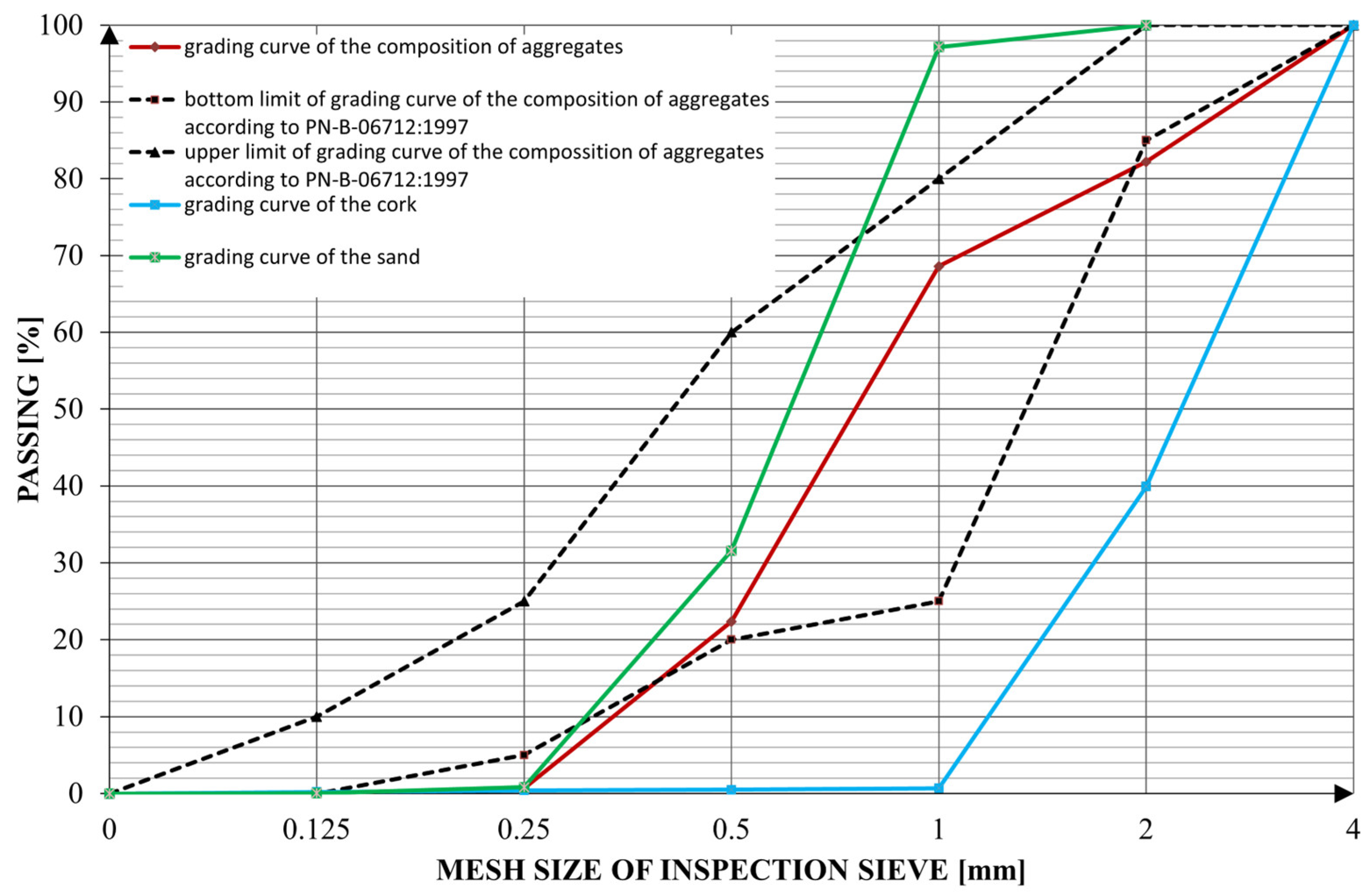
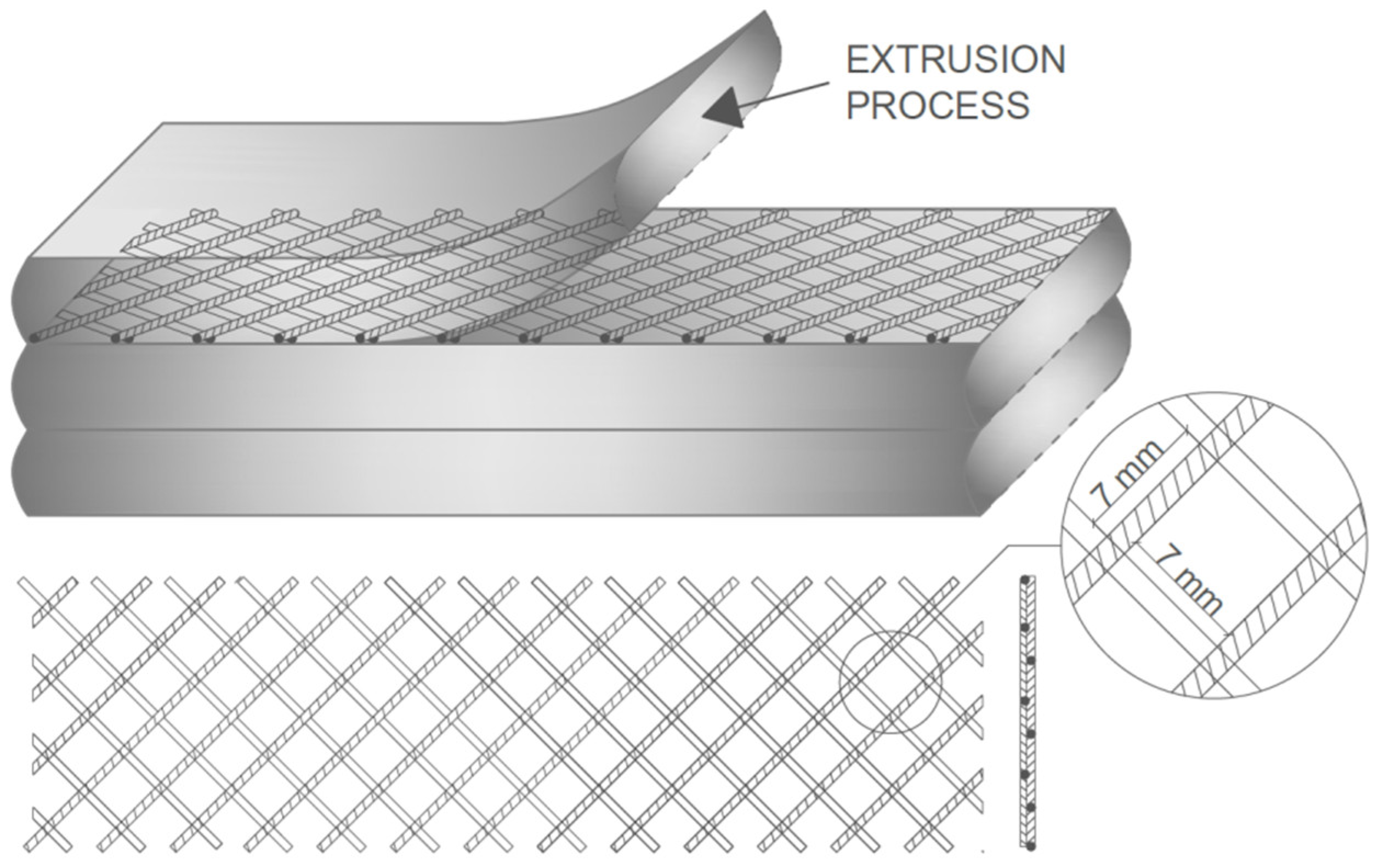
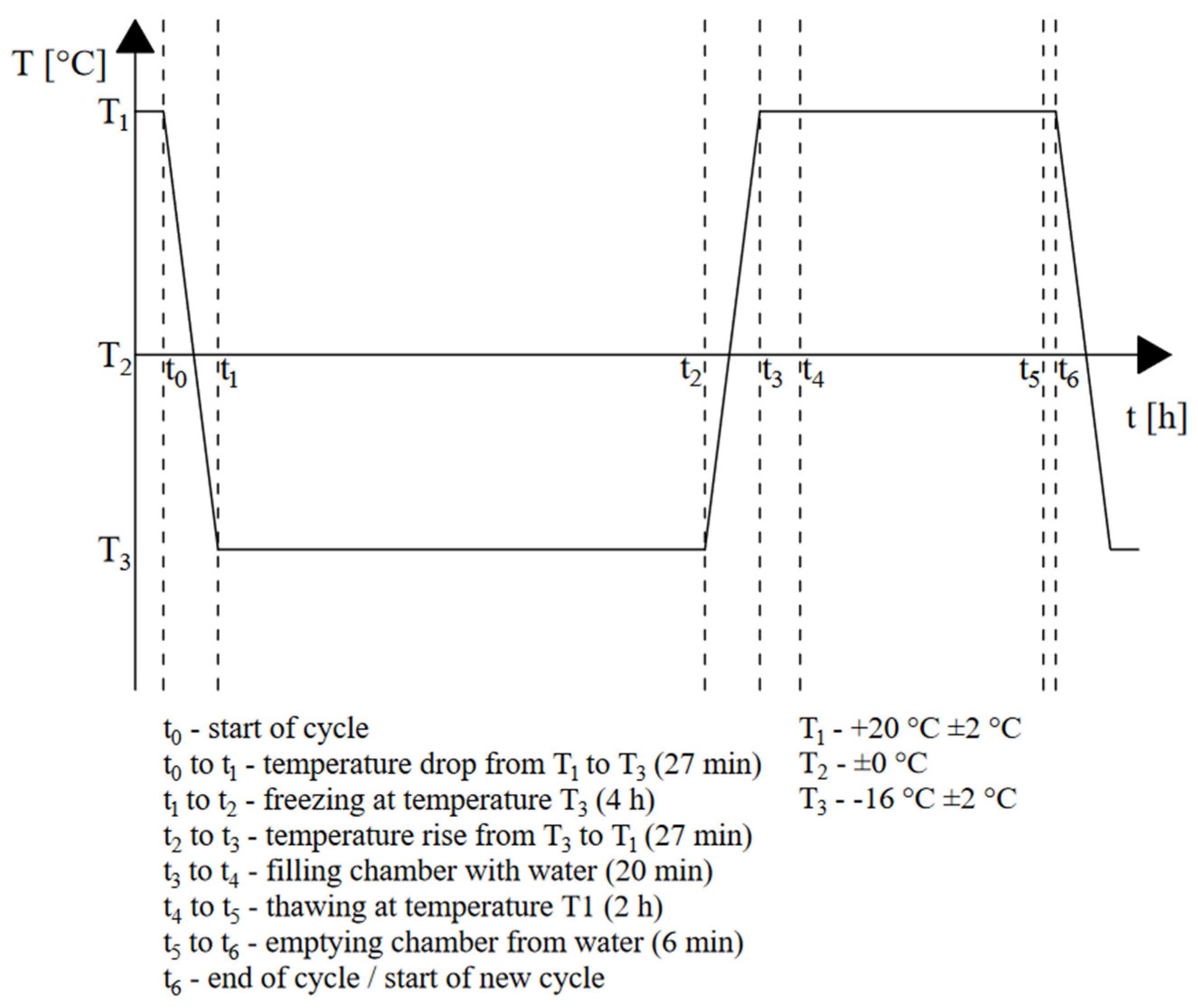
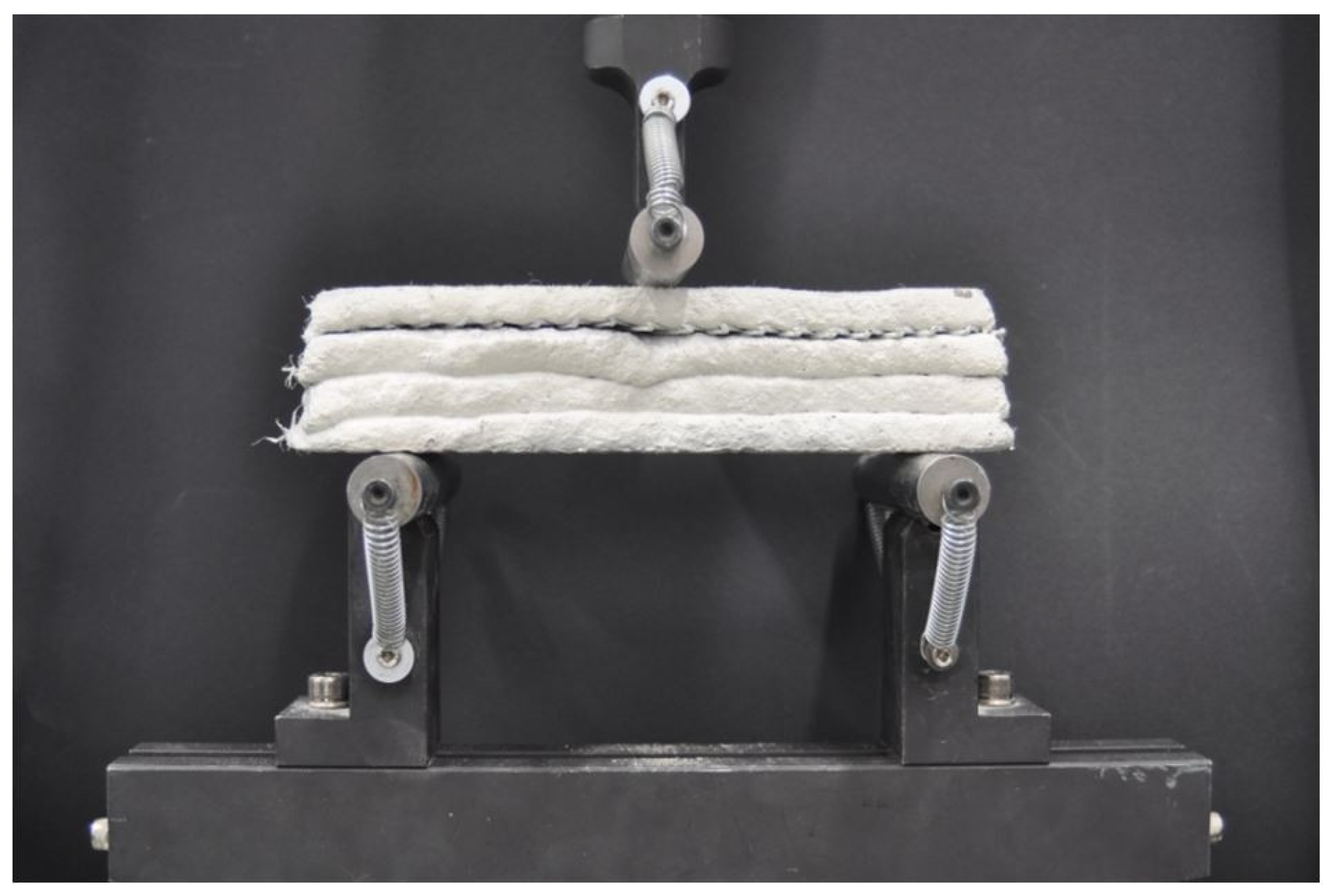
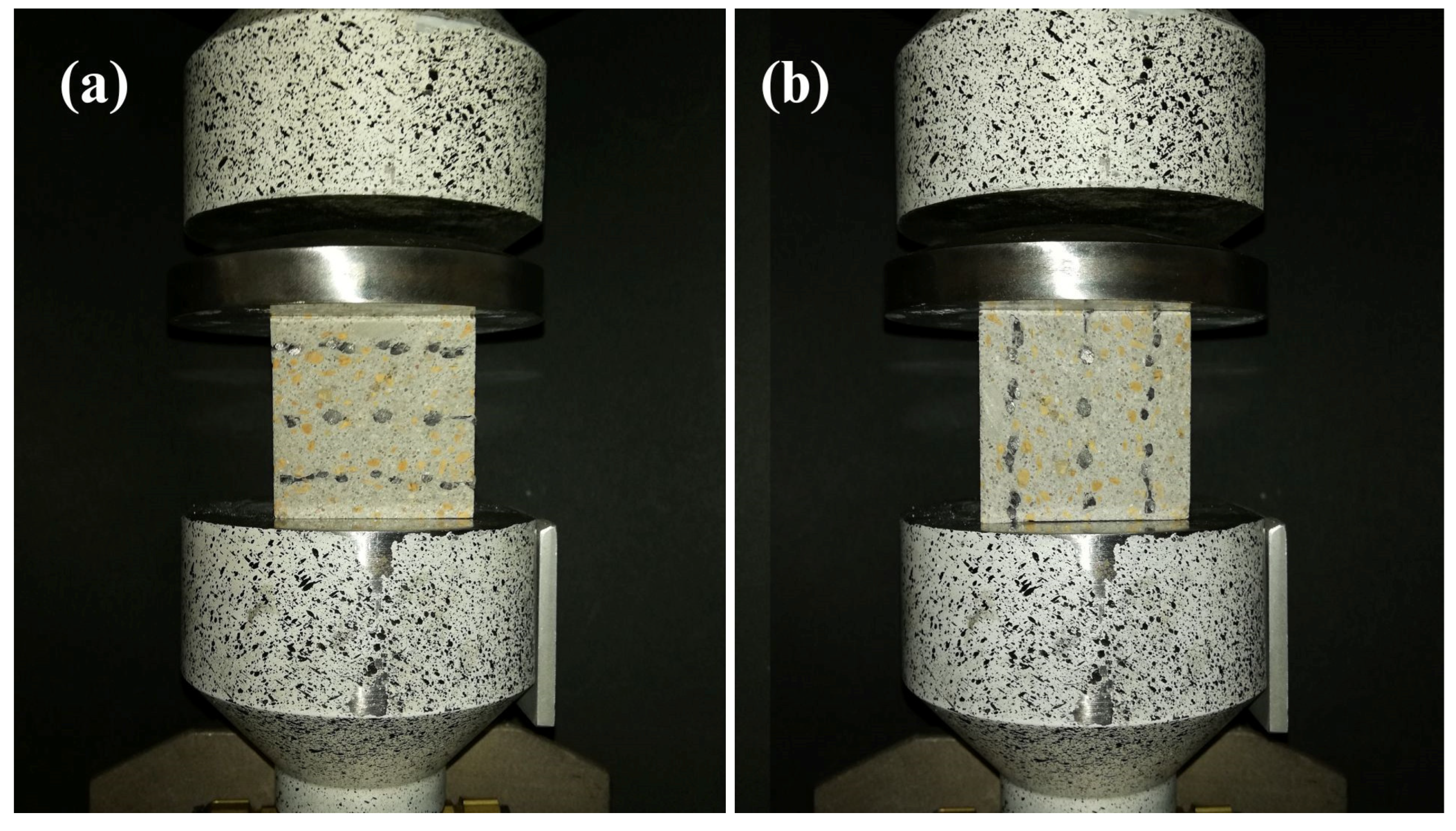
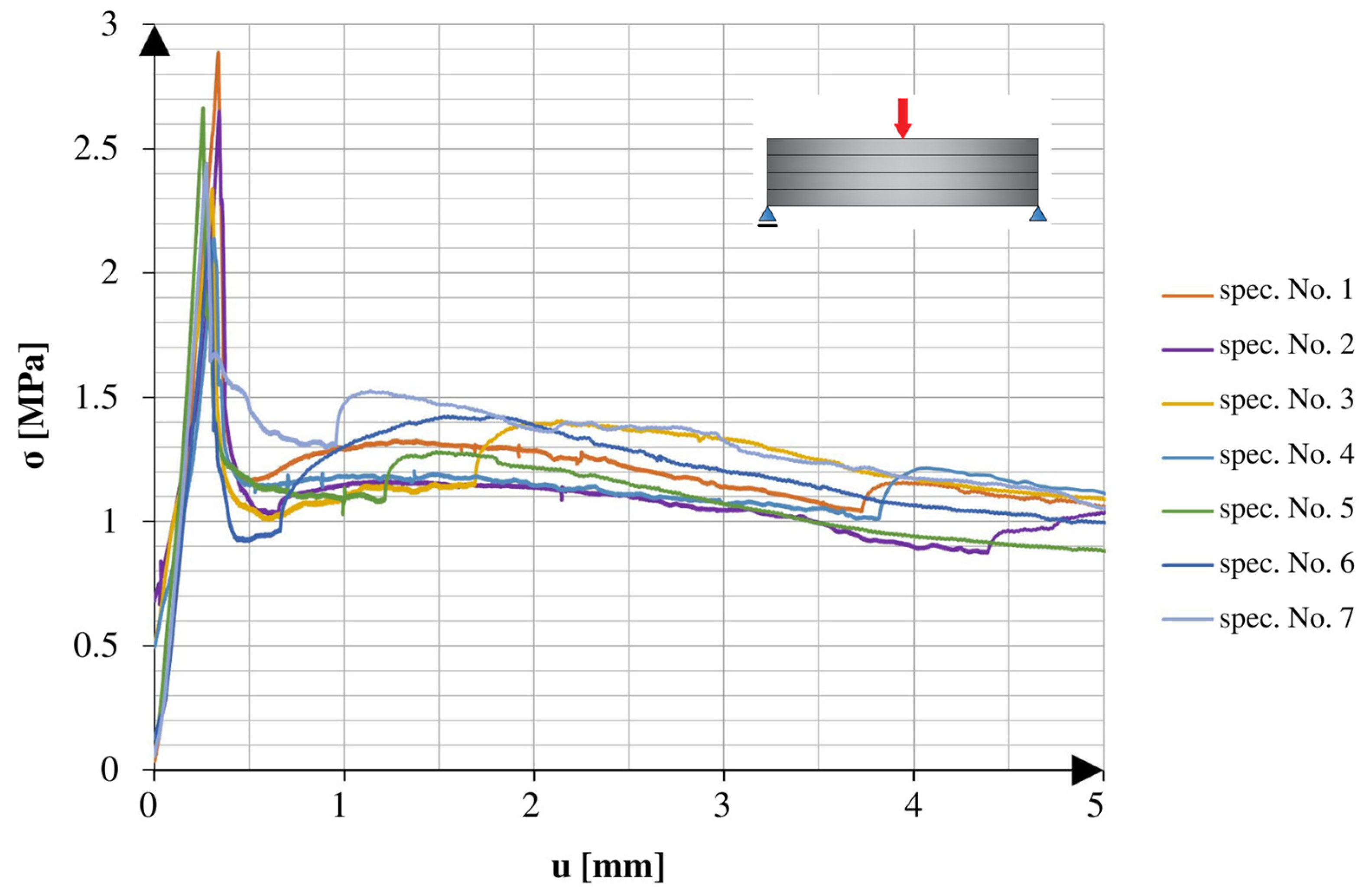
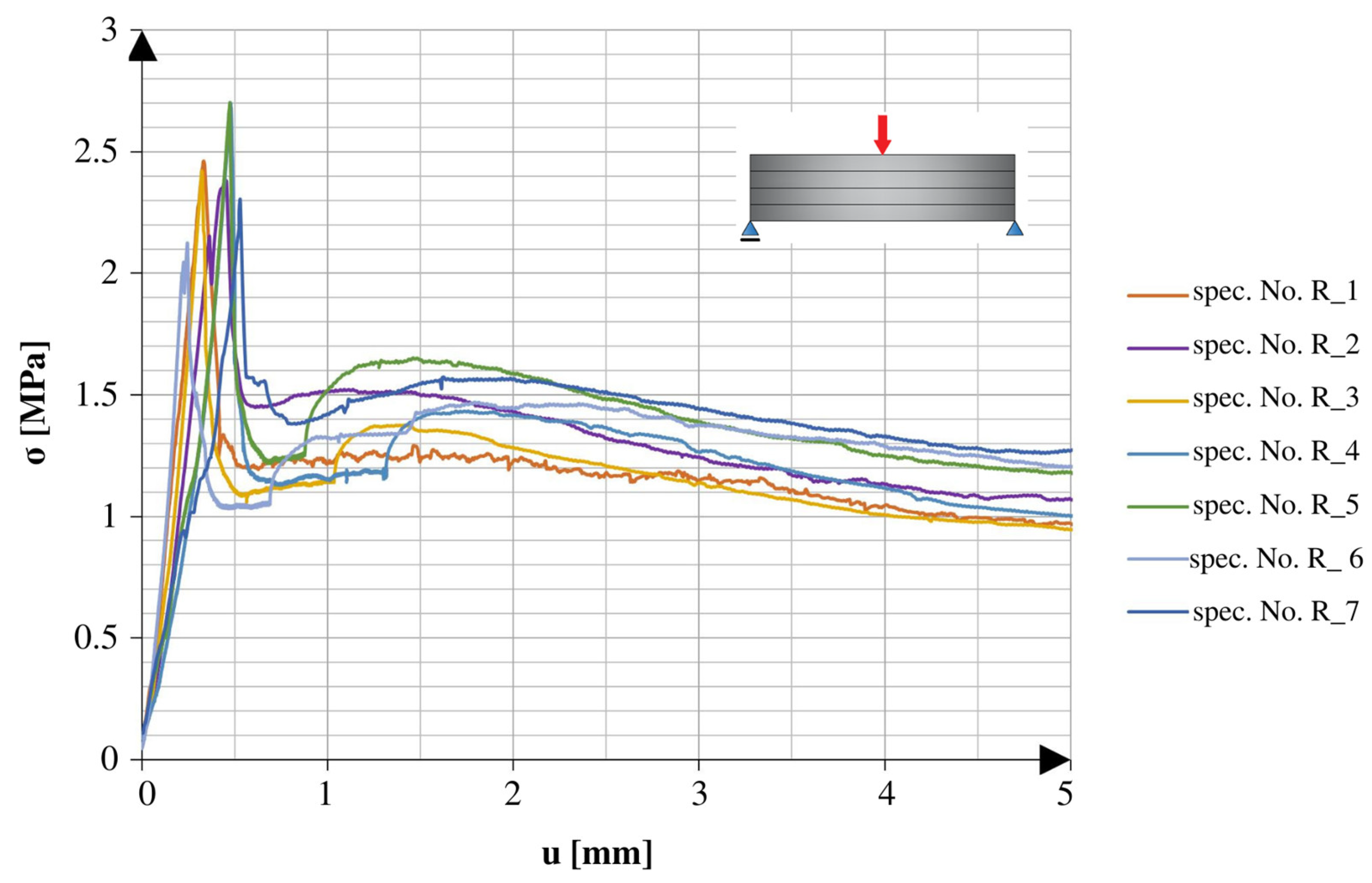
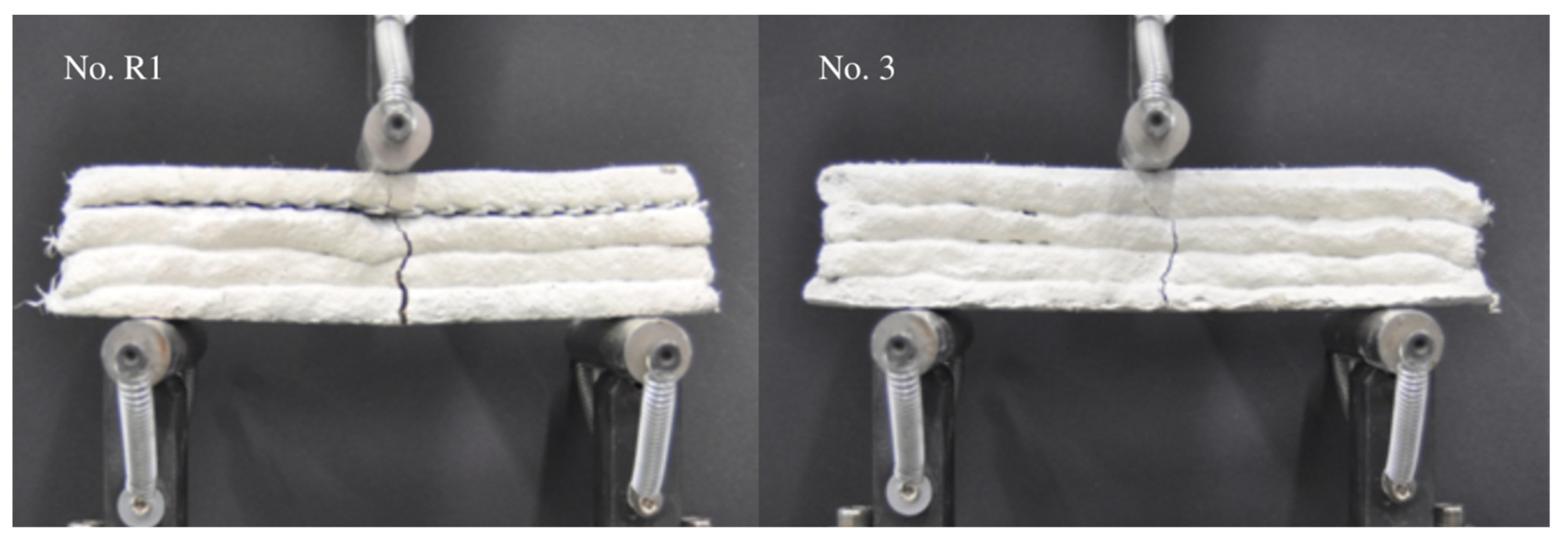
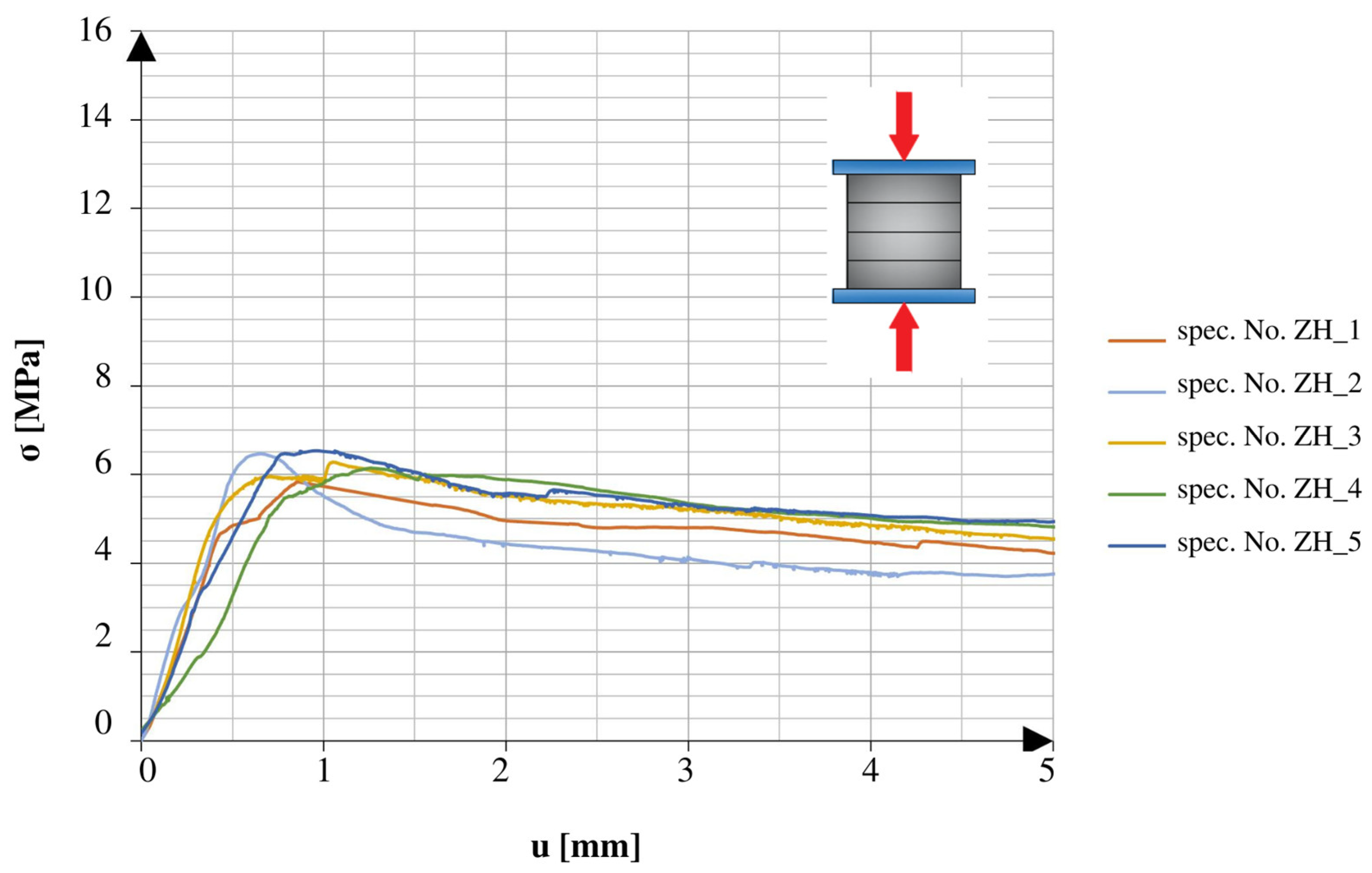
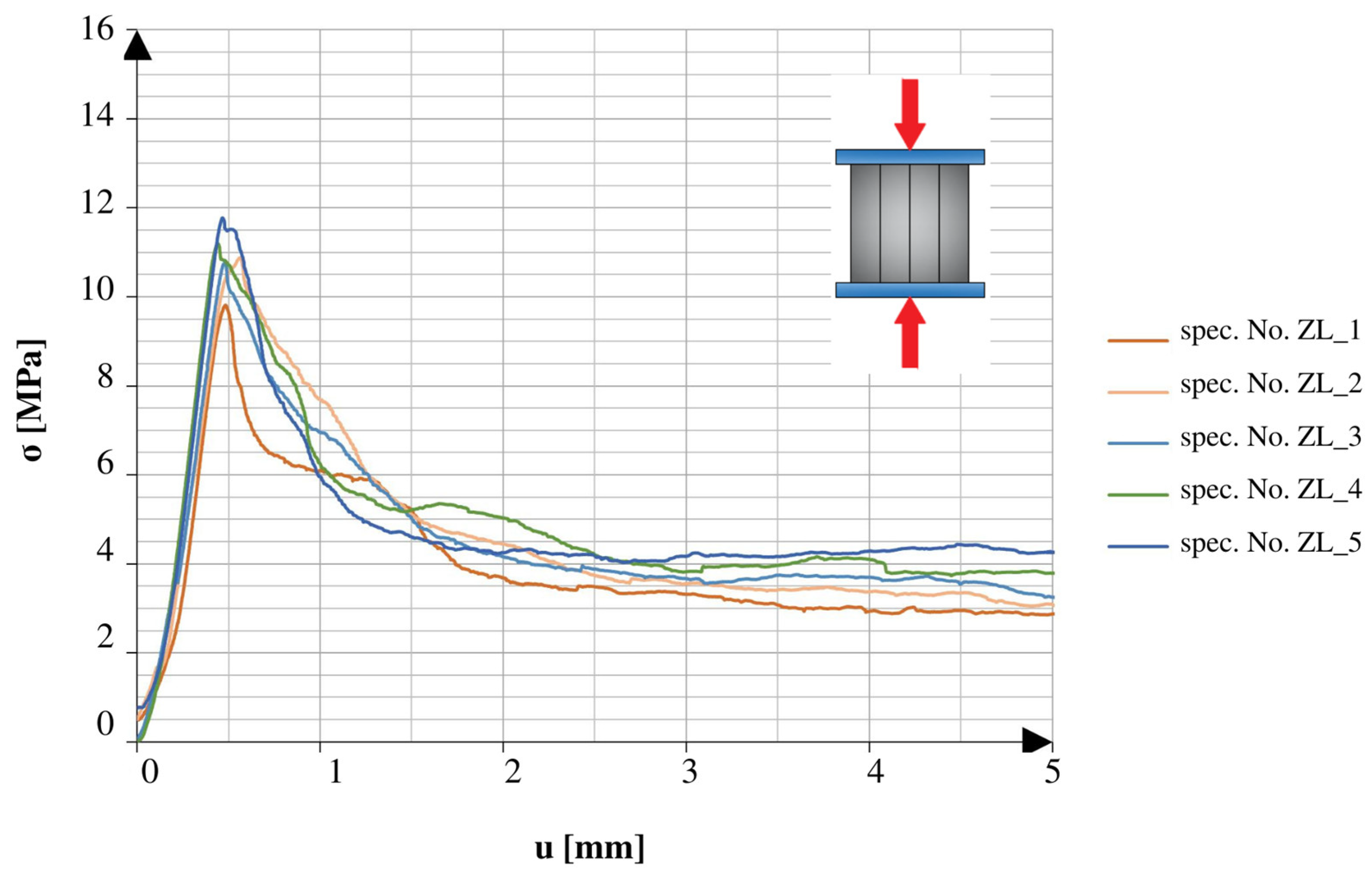
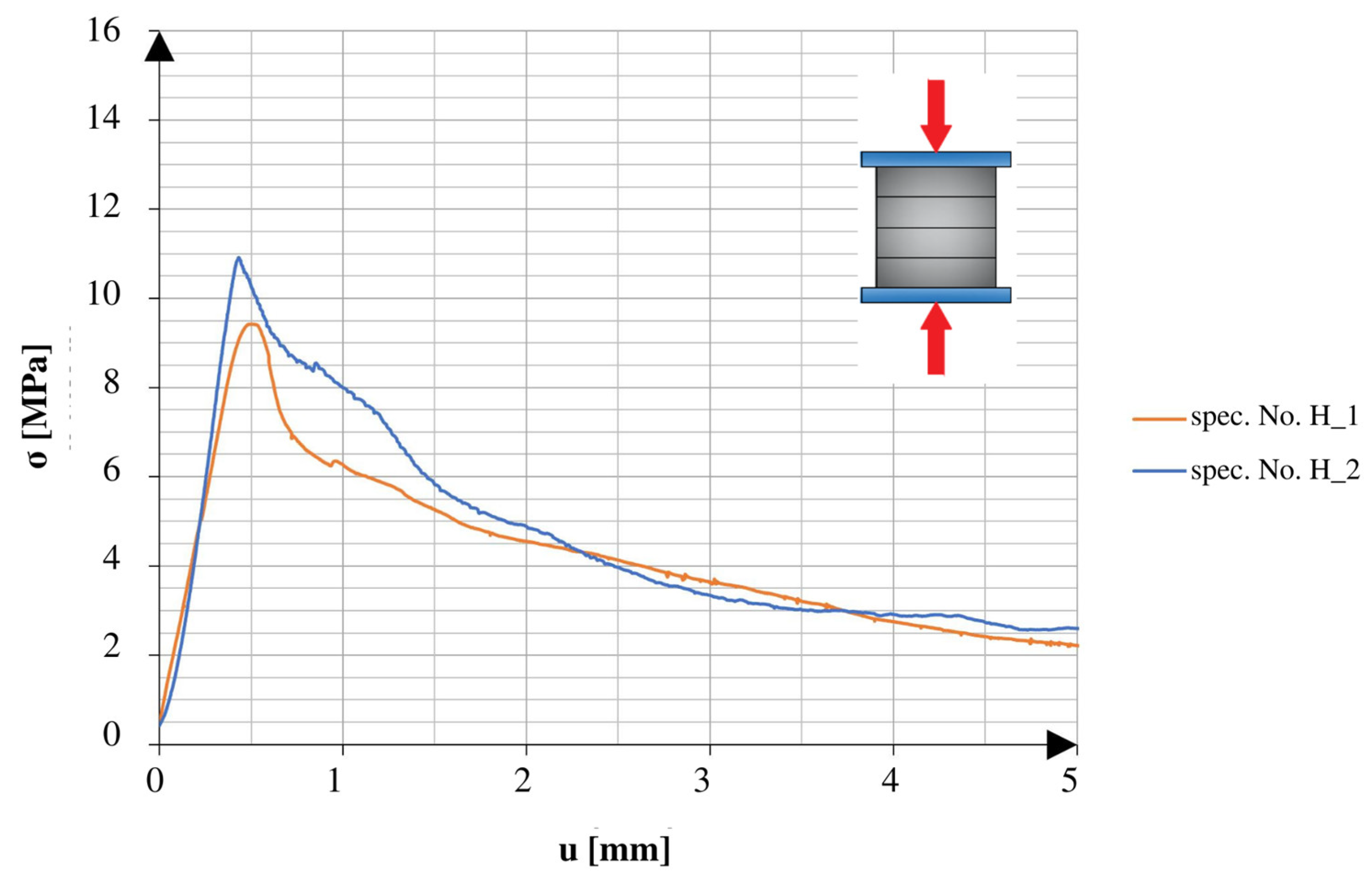
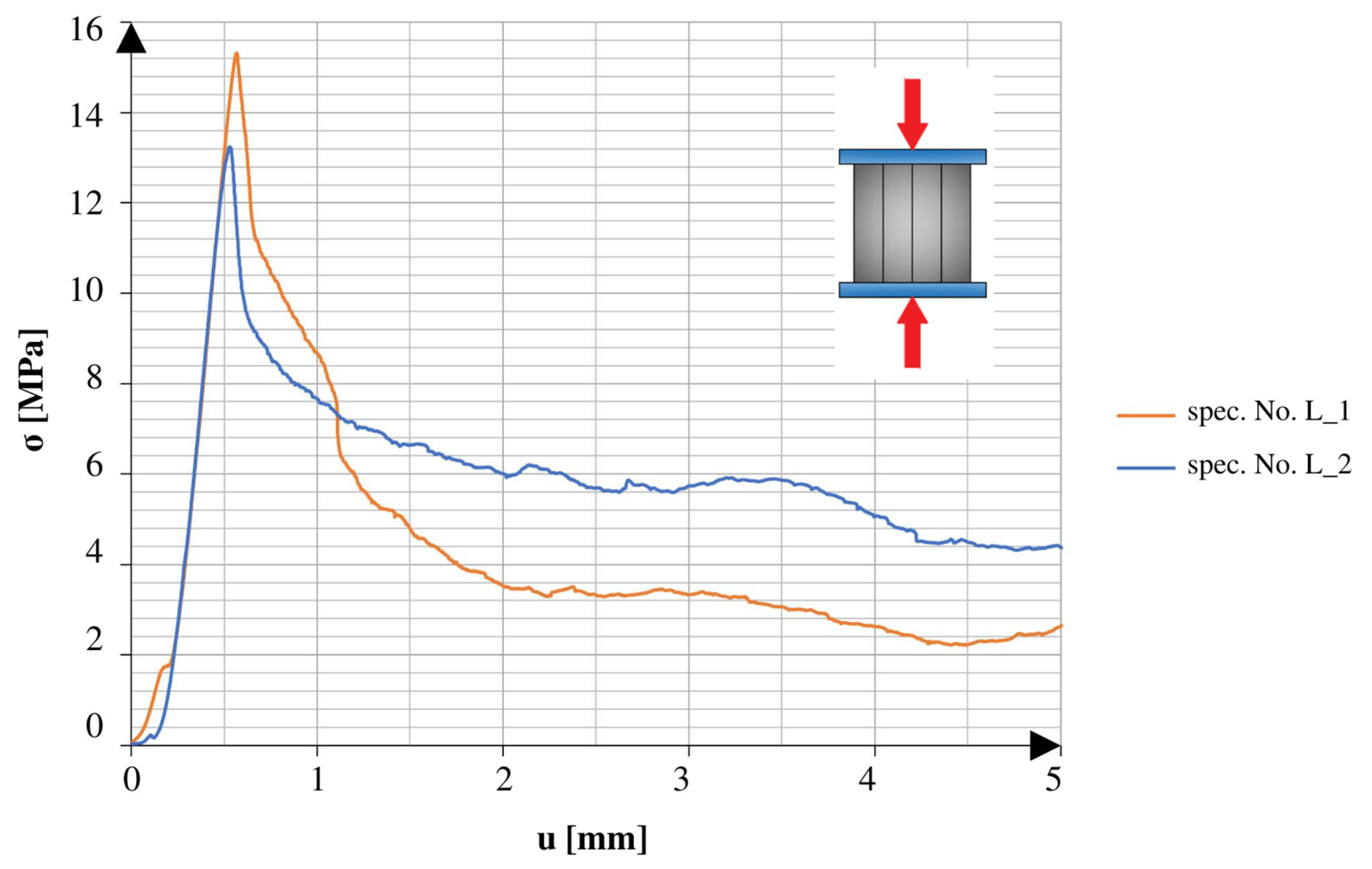
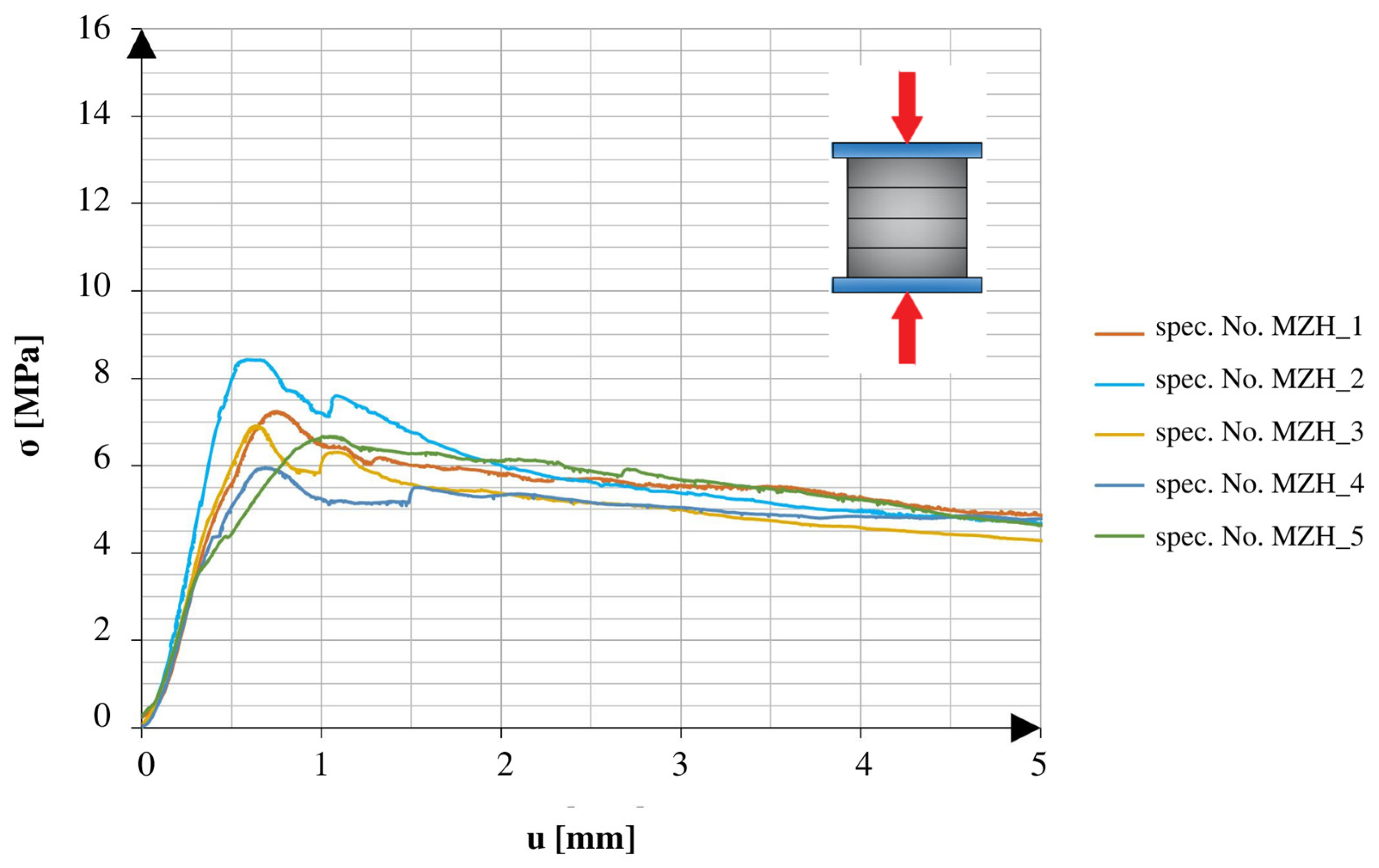
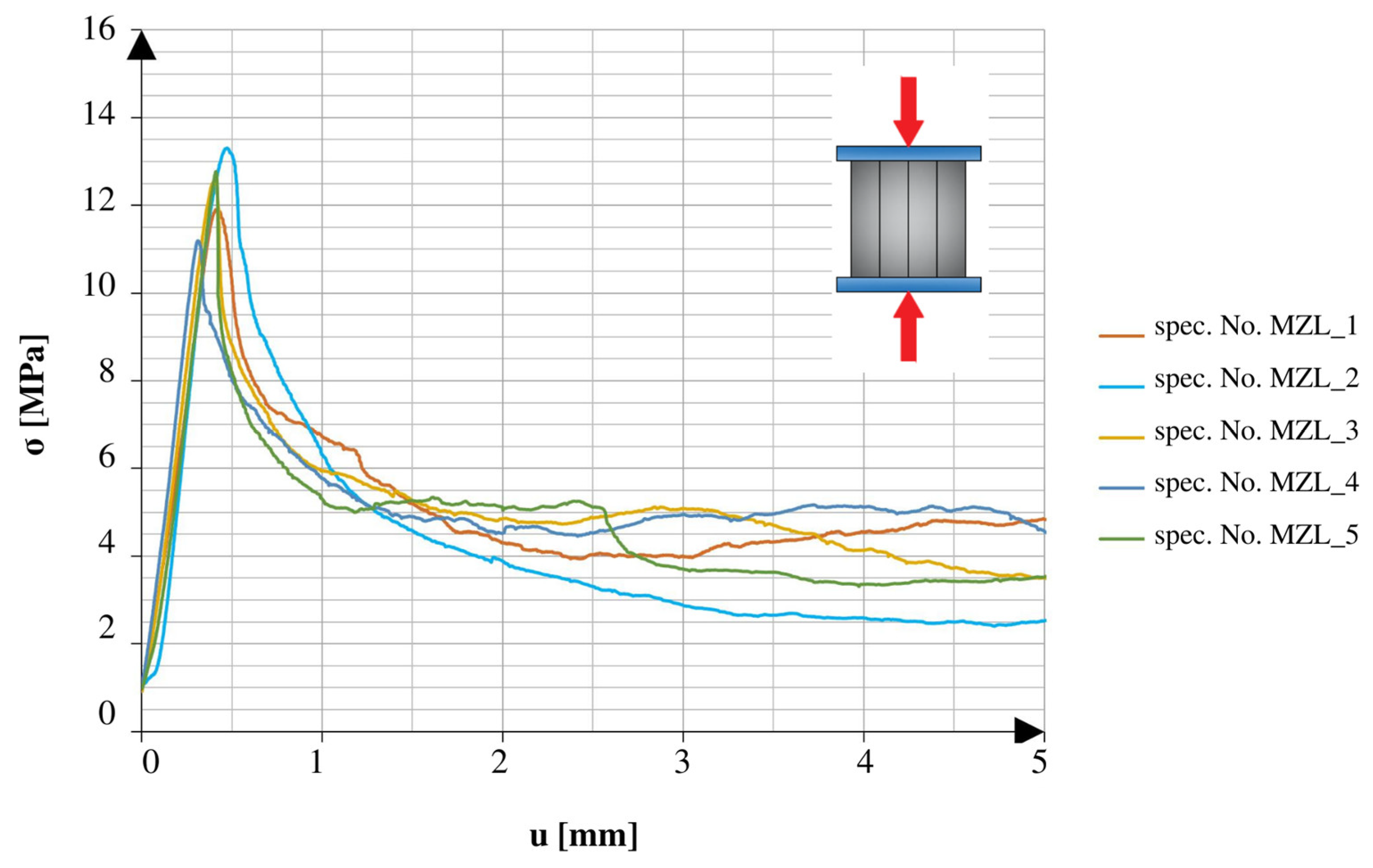


| The Mesh Size of the Inspection Sieve (mm) | Passing (%) | ||
|---|---|---|---|
| Sand | Cork | Composition | |
| 4.0 | - | 100.00 | 100.00 |
| 2.0 | 100.00 | 39.93 | 82.20 |
| 1.0 | 97.16 | 0.70 | 68.58 |
| 0.5 | 31.59 | 0.49 | 22.37 |
| 0.25 | 0.82 | 0.41 | 0.70 |
| 0.125 | 0.04 | 0.20 | 0.08 |
| 0.0 | 0.00 | 0.00 | 0.00 |
| Characteristics | Properties |
|---|---|
| Chloride ion content | ≤0.5% |
| Alkaline content | ≤0.8% |
| Aeration | Amount of air after mixing. Summarised amount of air A1 = (17 ± 3)% of volume |
| Amount of air after 1 h of holdup ≥ A1 − 3% | |
| Amount of air with longer mixing times ≤ A1 + 5% and ≥ A1 − 5% | |
| Corrosive influence | Contains ingredients from EN 934-1:2008 annex A. 1. only |
| Compressive strength | Tested mix ≥ 70% of control mix |
| Materials | The Amount for 1 m3 of Mixture |
|---|---|
| Cement | 381.2 kg |
| Sand | 747.9 kg |
| Cork granules | 13.6 kg |
| Water | 181.8 kg |
| Admixture | 1.5 kg |
| Fibre reinforcement | 1.4 kg |
| Specimen No. | Density | Water Absorption | |||
|---|---|---|---|---|---|
| ρ (g/cm3) | ρs (g/cm3) | ρn (g/cm3) | nw (%) | no (%) | |
| R1 | 1.635 | 1.611 | 1.805 | 12% | 19% |
| R2 | 1.612 | 1.590 | 1.783 | 12% | 19% |
| R3 | 1.374 | 1.353 | 1.534 | 13% | 18% |
| R4 | 1.606 | 1.580 | 1.794 | 14% | 22% |
| R5 | 1.502 | 1.477 | 1.678 | 14% | 20% |
| R6 | 1.620 | 1.592 | 1.808 | 14% | 22% |
| R7 | 1.587 | 1.560 | 1.775 | 14% | 22% |
| 1 | 1.486 | 1.462 | 1.666 | 14% | 20% |
| 2 | 1.600 | 1.572 | 1.782 | 13% | 21% |
| 3 | 1.643 | 1.617 | 1.837 | 14% | 22% |
| 4 | 1.466 | 1.443 | 1.640 | 14% | 20% |
| 5 | 1.452 | 1.431 | 1.630 | 14% | 20% |
| 6 | 1.486 | 1.463 | 1.664 | 14% | 20% |
| 7 | 1.544 | 1.509 | 1.717 | 14% | 21% |
| WCR1 | 1.671 | 1.646 | 1.857 | 13% | 21% |
| WCR2 | 1.609 | 1.586 | 1.789 | 13% | 20% |
| Avarage | 1.556 ± 0.082 | 1.531 ± 0.081 | 1.735 ± 0.087 | 14% ± 1% | 20% ± 1% |
| Specimen No. | Failure Stress | Specimen No. | Failure Stress |
|---|---|---|---|
| σ (MPa) | σ (MPa) | ||
| R1 | 2.462 | 1 | 2.888 |
| R2 | 2.383 | 2 | 2.651 |
| R3 | 2.422 | 3 | 2.339 |
| R4 | 2.700 | 4 | 2.140 |
| R5 | 2.703 | 5 | 2.665 |
| R6 | 2.125 | 6 | 2.140 |
| R7 | 2.301 | 7 | 2.442 |
| Avarage | 2.442 ± 0.193 | Avarage | 2.466 ± 0.262 |
| Specimen No. | Failure Stress | Specimen No. | Failure Stress |
|---|---|---|---|
| σ (MPa) | σ (MPa) | ||
| ZH1 | 5.835 | ZL1 | 9.816 |
| ZH2 | 6.468 | ZL2 | 10.877 |
| ZH3 | 6.280 | ZL3 | 10.760 |
| ZH4 | 6.145 | ZL4 | 11.194 |
| ZH5 | 6.536 | ZL5 | 11.775 |
| Avarage | 6.253 ± 0.250 | Avarage | 10.884 ± 0.640 |
| MZH1 | 7.242 | MZL1 | 11.905 |
| MZH2 | 8.430 | MZL2 | 13.308 |
| MZH3 | 6.912 | MZL3 | 12.538 |
| MZH4 | 5.959 | MZL4 | 11.195 |
| MZH5 | 6.671 | MZL5 | 12.773 |
| Avarage | 7.043 ± 0.812 | Avarage | 12.344 ± 0.730 |
| H1 | 9.423 | L1 | 15.321 |
| H2 | 10.917 | L2 | 13.243 |
| Avarage | 10.170 ± 0.747 | Avarage | 14.282 ± 1.039 |
Disclaimer/Publisher’s Note: The statements, opinions and data contained in all publications are solely those of the individual author(s) and contributor(s) and not of MDPI and/or the editor(s). MDPI and/or the editor(s) disclaim responsibility for any injury to people or property resulting from any ideas, methods, instructions or products referred to in the content. |
© 2023 by the authors. Licensee MDPI, Basel, Switzerland. This article is an open access article distributed under the terms and conditions of the Creative Commons Attribution (CC BY) license (https://creativecommons.org/licenses/by/4.0/).
Share and Cite
Pietras, D.; Zbyszyński, W.; Sadowski, T. A 3D Printing Method of Cement-Based FGM Composites Containing Granulated Cork, Polypropylene Fibres, and a Polyethylene Net Interlayer. Materials 2023, 16, 4235. https://doi.org/10.3390/ma16124235
Pietras D, Zbyszyński W, Sadowski T. A 3D Printing Method of Cement-Based FGM Composites Containing Granulated Cork, Polypropylene Fibres, and a Polyethylene Net Interlayer. Materials. 2023; 16(12):4235. https://doi.org/10.3390/ma16124235
Chicago/Turabian StylePietras, Daniel, Wojciech Zbyszyński, and Tomasz Sadowski. 2023. "A 3D Printing Method of Cement-Based FGM Composites Containing Granulated Cork, Polypropylene Fibres, and a Polyethylene Net Interlayer" Materials 16, no. 12: 4235. https://doi.org/10.3390/ma16124235
APA StylePietras, D., Zbyszyński, W., & Sadowski, T. (2023). A 3D Printing Method of Cement-Based FGM Composites Containing Granulated Cork, Polypropylene Fibres, and a Polyethylene Net Interlayer. Materials, 16(12), 4235. https://doi.org/10.3390/ma16124235






